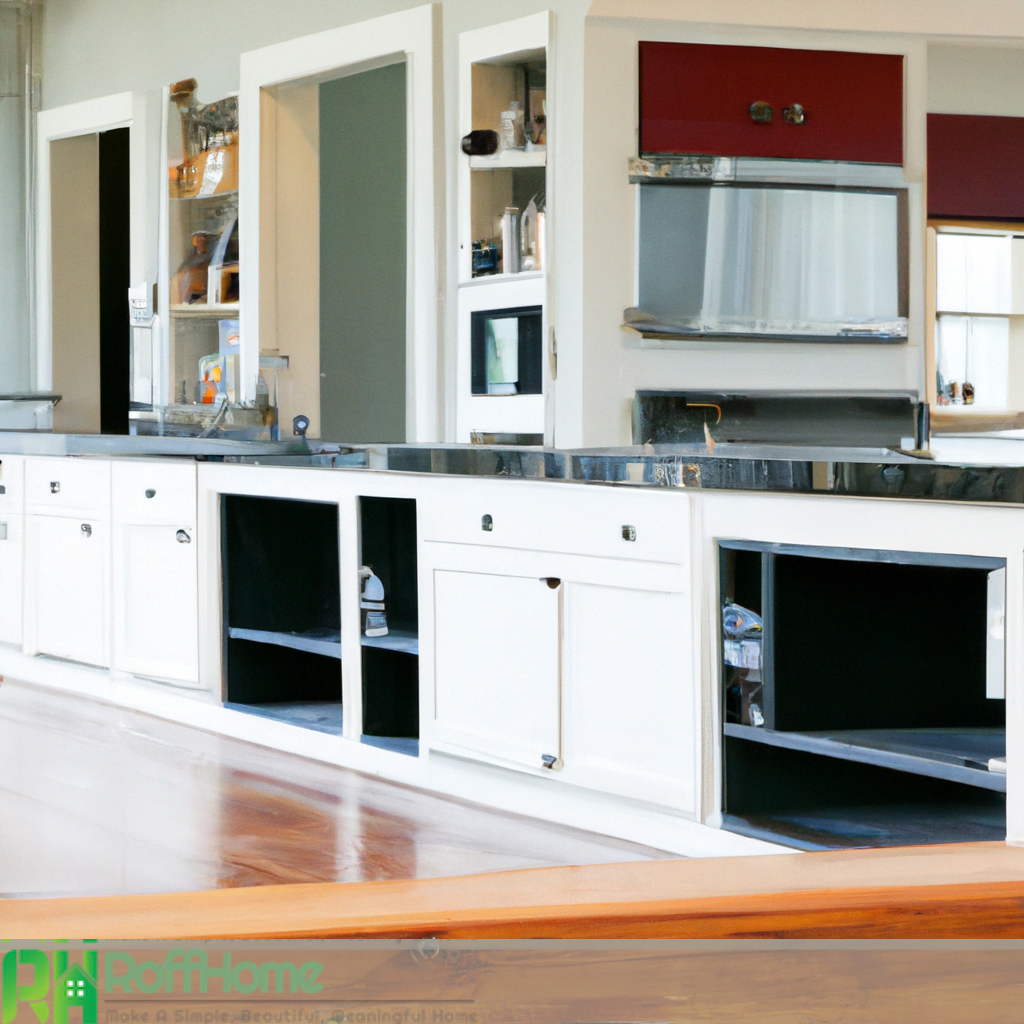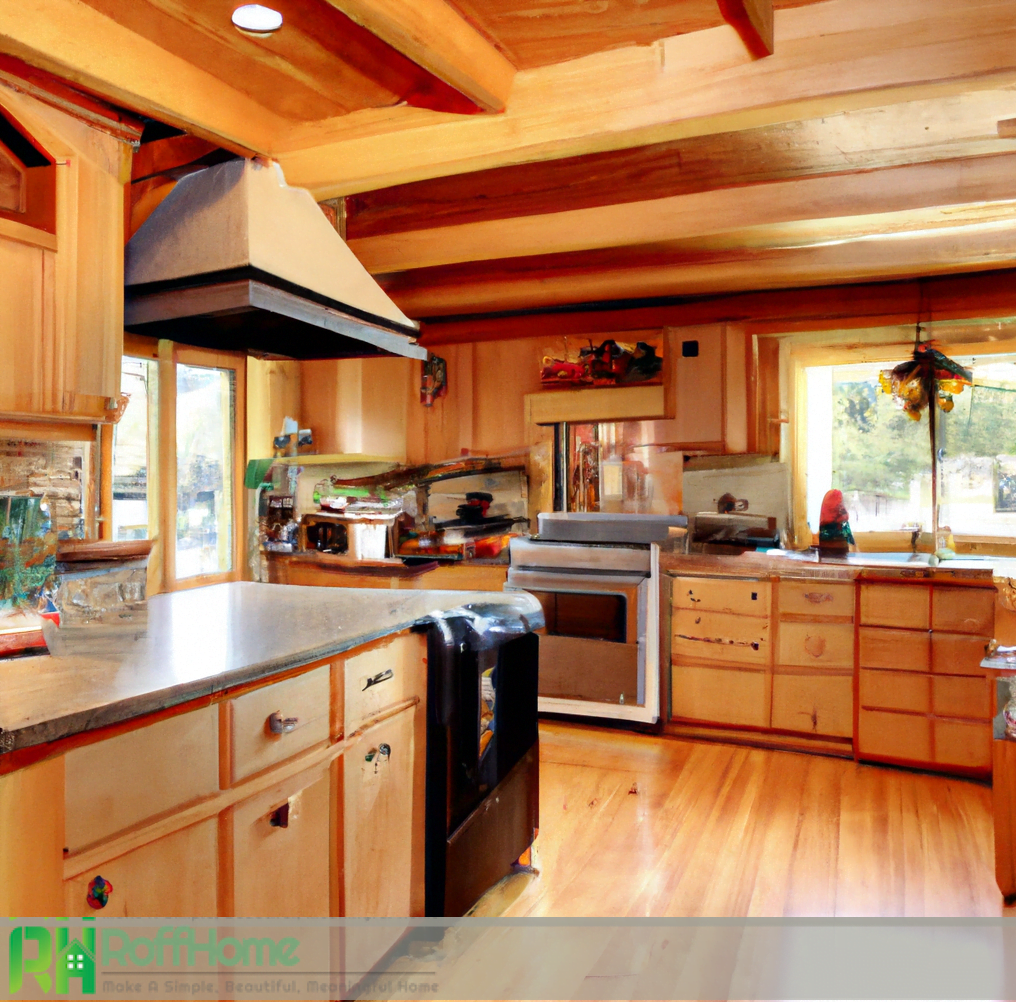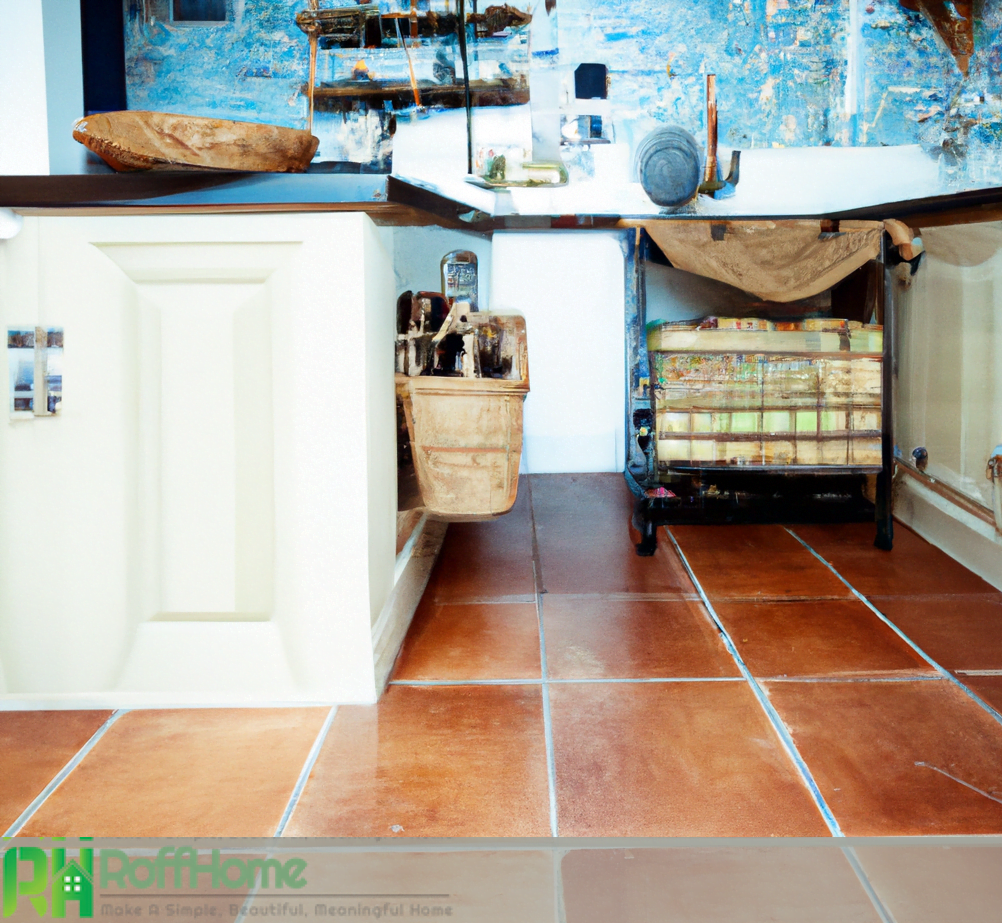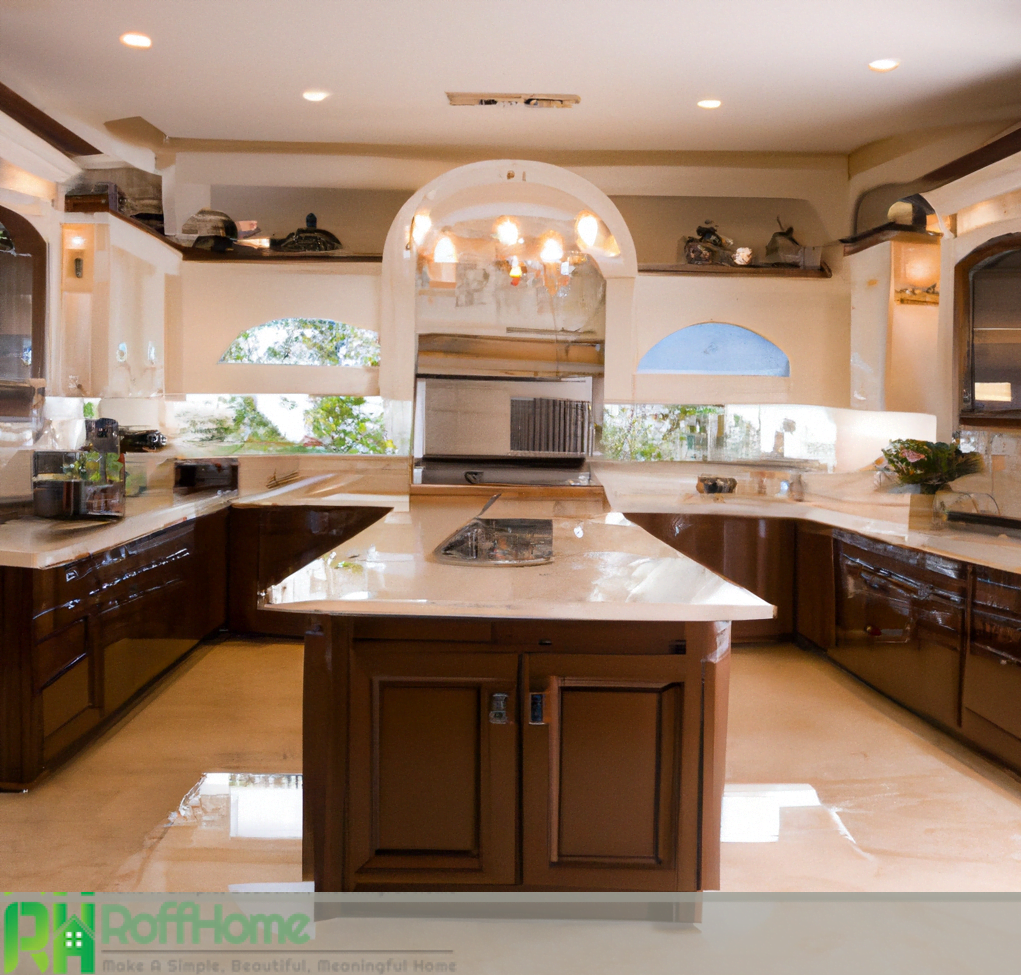Embracing Elegance: The Alluring Aesthetics of Dark Cabinets with Dark Countertops in 2023
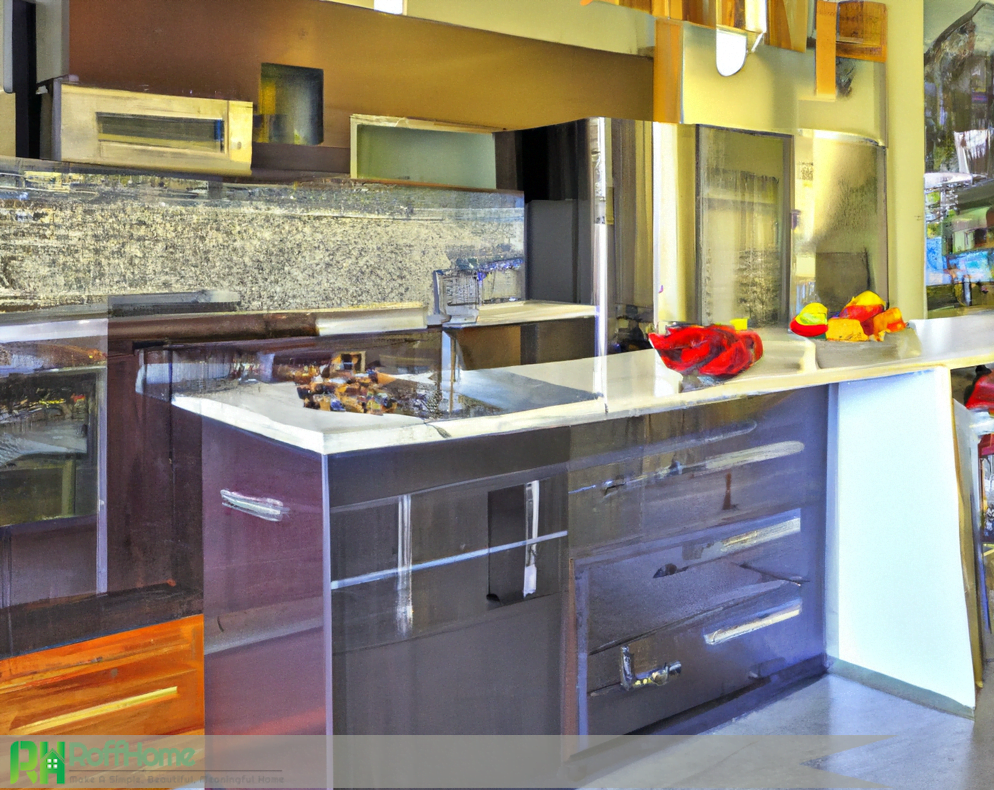
The combination of dark cabinets with dark countertops allows for a bold statement in kitchen design, providing a sharp contrast against lighter elements and enhancing the depth and richness of the overall color scheme. This design option is ideal for creating a stylish and sophisticated, cohesive look.
Lighting also plays an important role in achieving the desired effect with dark cabinets and countertops. Proper lighting can highlight the textures and patterns of the materials used and create a comfortable and inviting atmosphere in the kitchen.
Popular materials for dark countertops include natural stones such as granite and quartz, which offer durability and low maintenance while adding a touch of elegance to the kitchen. Properly coordinated with other elements such as furniture, flooring, backsplash, wall paint, kitchen accessories, dark cabinets and countertops can create a unique and striking, functional, and aesthetically pleasing space.
Design Tips for Creating an Eye-Catching Look with Dark Cabinets and Dark Countertops
Designing a kitchen with dark cabinets and countertops requires careful planning to achieve an eye-catching and visually stunning result. Here are some tips for creating an appealing look with these bold design elements.
Balance the color scheme: The key to successfully integrating dark cabinets and countertops is to balance the color scheme. One approach is introducing light elements such as light-colored backsplash, flooring, or walls to offset the dark cabinets and countertops. This creates a harmonious balance between light and dark elements and prevents the space from feeling too heavy or overwhelming.
Play with lighting: Lighting is crucial when working with dark colors. It is important to have adequate lighting in the kitchen to highlight the textures and patterns of the materials used. Incorporating under-cabinet lighting or pendant lights can provide both functional and decorative lighting, highlighting the beauty of the cabinets and countertops.
Choose the right materials: Choosing the right materials is critical to achieving a cohesive look. Dark cabinets and countertops can be paired with various materials, including natural stones, such as granite or quartz, or even matte finishes to create a modern look.
Add contrast: Introducing contrasting colors can create visual interest and help break up the monotony of a dark color scheme. For example, lighter-colored handles and knobs can help provide contrast against dark cabinets and countertops.
Accessorize with intention: Intentionally choosing kitchen accessories, such as decorative accents, kitchen appliances, and even cookware, can help to tie the look together. Choosing accessories that match or complement the color scheme can make the space feel cohesive and well-designed.
Consider the overall aesthetic: Dark cabinets and countertops can lend themselves to different design aesthetics, from traditional to modern. Choosing the right cabinetry and countertop styles to suit the kitchen’s overall aesthetic can help create a unified look.
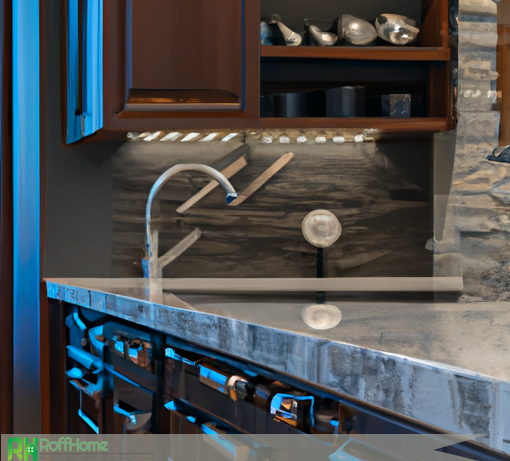
How to Create a Modern Look with Dark Cabinets and Dark Countertops
Designing a modern kitchen with dark cabinets and countertops requires careful planning and attention to detail. Here are some tips for creating a modern look with dark cabinets and countertops.
Choose clean lines and sleek finishes: A modern kitchen is characterized by clean lines, simple shapes, and sleek finishes. Choose cabinetry with clean lines and minimal detailing to achieve a modern look. Pair this with dark countertops with a matte or polished finish for a sleek and sophisticated look.
Create a monochromatic color scheme: A monochromatic color scheme can help to create a modern look. Dark cabinets and countertops can be paired with other elements in the kitchen that are similar in color, such as a dark backsplash, to create a cohesive look. Introducing a touch of contrast with light fixtures or appliances in a contrasting color can help break up the monochromatic color scheme.
Introduce lighting that adds depth: Lighting is a key component in creating a modern look. Adding ambient lighting, such as under-cabinet lighting or pendant lights, can help highlight the textures and patterns in the materials used in the kitchen. This creates a sense of depth and interest in the space.
Incorporate natural materials: Modern design often incorporates natural materials such as wood, stone, and metal. To add warmth to the space, consider incorporating wood elements, such as wood flooring or open shelving, to soften the look. Natural stone countertops, such as granite or quartz, can also add a touch of sophistication and texture to the space.
Keep it minimal: A modern kitchen is all about simplicity and minimalism. Keep the space clutter-free and organized with minimal accessories and decor. Choose only a few decorative accents that fit the kitchen’s overall aesthetic.
Combining Different Styles with Dark Cabinets and Dark Countertops
Combining different styles with dark cabinets and countertops can create a unique and visually appealing kitchen. Here are some tips for successfully integrating different styles with dark cabinets and countertops.
Start with a unifying theme: Combining different styles can be challenging, but starting with a unifying theme can help to create a cohesive look. For example, you could choose a color palette that ties together the different styles, such as warm earth tones.
Mix and match cabinetry styles: Mixing and matching different cabinetry styles can add visual interest to the kitchen. Consider using both open shelving and closed cabinets to create a modern and traditional look. Combining different cabinet finishes, such as matte and glossy, can add dimension to the space.
Introduce different countertop materials: Introducing different countertop materials can help to create a unique look. Combining dark countertops with lighter materials, such as butcher blocks or marble, can create a nice contrast. This approach can add depth to the kitchen while maintaining a cohesive look.
Mix different design elements: Consider introducing different design elements into the kitchen, such as vintage or industrial accessories. Using a mix of vintage and modern accessories can create a unique and eclectic look.
Choose contrasting materials: Pairing dark cabinets and countertops with contrasting materials, such as light-colored backsplash or flooring, can help to balance the color scheme. This creates a harmonious balance between light and dark elements and prevents the space from feeling too heavy or overwhelming.
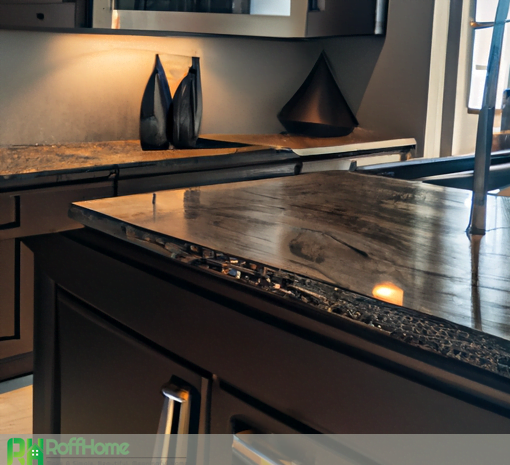
Combining Different Shades of Dark Colors in Kitchen Design: Tips and Tricks
Combining different shades of dark colors in kitchen design can add depth, dimension, and visual interest to the space. However, it requires a careful balance of color and contrast to achieve a cohesive and harmonious look. Here are some tips and tricks for combining shades of dark colors in kitchen design.
Choose a dominant color: Choose one dark color to be the dominant color in the space, such as dark brown or black. This will anchor the color scheme and provide a consistent look throughout the kitchen.
Introduce contrast: Introducing contrast is important when using dark colors. To prevent the space from feeling too heavy or overwhelming, introduce light or bright accents, such as a light backsplash or light-colored flooring. This creates a harmonious balance between light and dark elements.
Use texture: Introducing texture can help to break up the monotony of using one color in the space. Consider using different materials with contrasting textures, such as a matte cabinet finish paired with a polished countertop. This creates visual interest and adds depth to the space.
Layer shades of the dominant color: Layering different shades of the dominant color can create a cohesive look. Use lighter shades of the color on upper cabinets or walls and darker shades on lower cabinets or flooring. This helps to create a sense of balance and proportion in the space.
Consider the lighting: Lighting is important when using dark colors in the kitchen. Good lighting can highlight the textures and patterns of the materials used, while bad lighting can make the space dark and uninviting. Consider using under-cabinet lighting or pendant lights to help create a warm and inviting atmosphere.
Tips for Installing Dark Cabinets and Dark Countertops
Dark cabinets and countertops can create a dramatic and sophisticated look in any kitchen. However, some important considerations should be considered when installing these features. Here are some tips for installing dark cabinets and dark countertops.
Consider the lighting: Dark cabinets and countertops can make a kitchen feel smaller
and darker. It’s important to have good lighting to ensure that the space feels warm and inviting. Consider adding under-cabinet lighting, pendant lights, or recessed lighting to illuminate the space.
Choose durable materials: Dark cabinets and countertops can show scratches, chips, and stains more easily than lighter materials. Choose durable and easy-to-maintain materials such as granite, quartz, or other natural stones.
Please pay attention to the color scheme: When installing dark cabinets and countertops, it’s important to pay attention to the overall color scheme of the kitchen. Introduce lighter elements, such as a light-colored backsplash or flooring, to create a balance between light and dark colors.
Use contrasting materials: To prevent the space from feeling too heavy or monochromatic, consider using contrasting materials. For example, you could use light-colored hardware or introduce a light-colored island to break up the space.
Consider the layout: Dark cabinets and countertops can create a sense of visual weight in the kitchen. Consider the layout of the space to ensure that it feels balanced and functional. You may need to introduce additional light elements or adjust the layout to ensure the space feels comfortable.
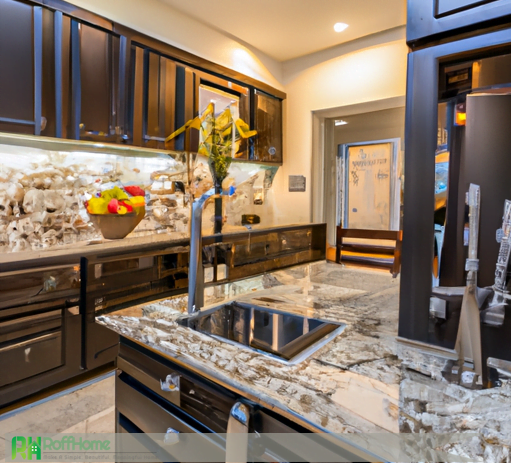
The impact of lighting on dark cabinets with dark countertops in kitchen design
Lighting is crucial in kitchen design, especially when working with dark cabinets and countertops. The right lighting can enhance the beauty of these elements, while poor lighting can make the space gloomy and uninviting. Here are some ways lighting impacts dark cabinets and countertops in kitchen design.
Illuminating the space: Good lighting can illuminate the space and highlight the textures and colors of the cabinets and countertops. Under-cabinet lighting is popular for dark cabinets as it provides focused task lighting and adds a warm and inviting glow to the space.
Enhancing the color scheme: Lighting can also help enhance the kitchen’s overall color scheme. Warm lighting, such as LED or incandescent bulbs, can help to bring out the warm tones in dark wood cabinets, while cooler lighting, such as fluorescent bulbs, can bring out the cool tones in granite or marble countertops.
Creating visual interest: Lighting can create visual interest in the space. For example, pendant lights above a kitchen island can draw the eye upwards and create a focal point in the room. This can help break up the visual weight of dark cabinets and countertops and make the space more balanced.
Adjusting the mood: Lighting can also be used to adjust the mood of the space. For example, dimmable lighting can create a warm and cozy atmosphere for intimate dinners, while bright lighting can be used for cooking or entertaining.
Maintenance and cleaning tips for dark cabinets and countertops
Dark cabinets and countertops can add a touch of elegance and sophistication to a kitchen. However, they also require more attention and maintenance compared to their lighter counterparts. Here are some maintenance and cleaning tips for dark cabinets and countertops.
Clean up spills immediately: Dark countertops, especially those made of porous materials like granite, can easily absorb liquids and leave stains. Wipe up spills immediately with a damp cloth to prevent staining.
Avoid abrasive cleaners: Harsh chemical cleaners and abrasive sponges can scratch and damage dark cabinets and countertops. Use mild soap and warm water to clean them instead. You can also use specialized granite or quartz cleaners, but ensure they are safe for dark colors.
Use a soft cloth: When wiping dark cabinets and countertops, use a soft cloth or microfiber towel to avoid scratching the surfaces. Avoid using rough materials like steel wool or scouring pads.
Avoid direct sunlight: Prolonged exposure to direct sunlight can cause dark cabinets and countertops to fade or discolor. Use window coverings or blinds to protect them from direct sunlight.
Regularly clean cabinets: Dark cabinets can show dust and fingerprints more easily than lighter cabinets. Clean them regularly with a soft cloth to prevent buildup.
Seal countertops: If your countertops are made of natural stone, like granite or marble, they may need to be sealed to prevent staining. Check with your manufacturer for specific sealing instructions.
Pros and cons of using dark cabinets and dark countertops in the kitchen
Dark cabinets and dark countertops are popular choices for modern kitchens. They add depth and sophistication to the space, but there are pros and cons to using these elements in kitchen design. Here are some of the key pros and cons to consider.
Pros:
Elegance and sophistication: Dark cabinets and countertops are associated with luxury and elegance. They can add depth and warmth to a kitchen, creating a sense of sophistication and style.
Contrast and depth: When paired with light elements, such as walls, backsplashes, or flooring, dark cabinets and countertops can create a striking contrast that adds depth and interest to the space.
Durability: Many dark cabinets and countertops are made from durable materials like granite, quartz, or wood. These materials are resistant to scratches, stains, and other types of damage.
Cons:
Maintenance: Dark countertops can be more difficult to maintain than lighter colors. They can show smudges, dust, and fingerprints more easily. Additionally, dark wood cabinets require frequent polishing and maintenance to maintain their shine.
Overwhelming: Dark cabinets and countertops can be overwhelming in a small kitchen or with limited natural light. They can make the space cramped and gloomy, especially if not paired with light elements or proper lighting.
Limited color palettes: Dark cabinets and countertops can limit the kitchen’s color palette. They work best with neutral colors or light tones to create contrast and balance.
Dark cabinets with dark countertops are popular for modern kitchens, but they have advantages and disadvantages. By considering the design tips, color combinations, maintenance and cleaning, and lighting impact, homeowners can make an informed decision on incorporating these elements into their kitchen design.

